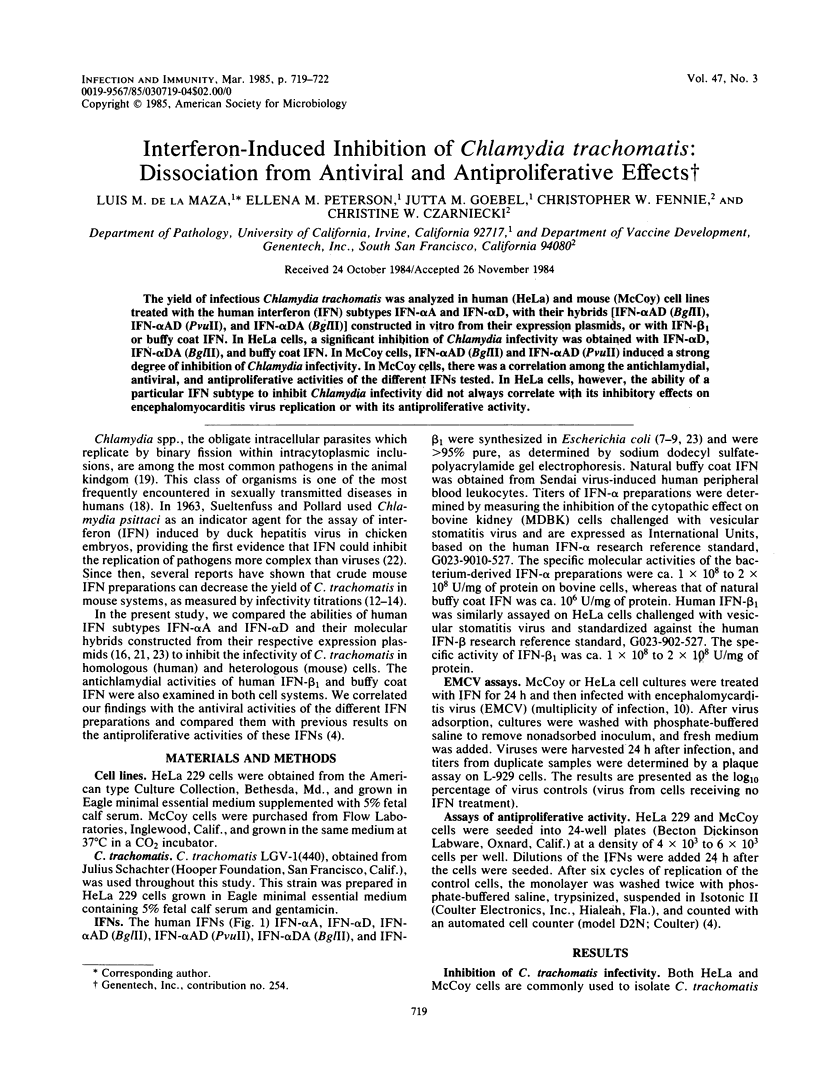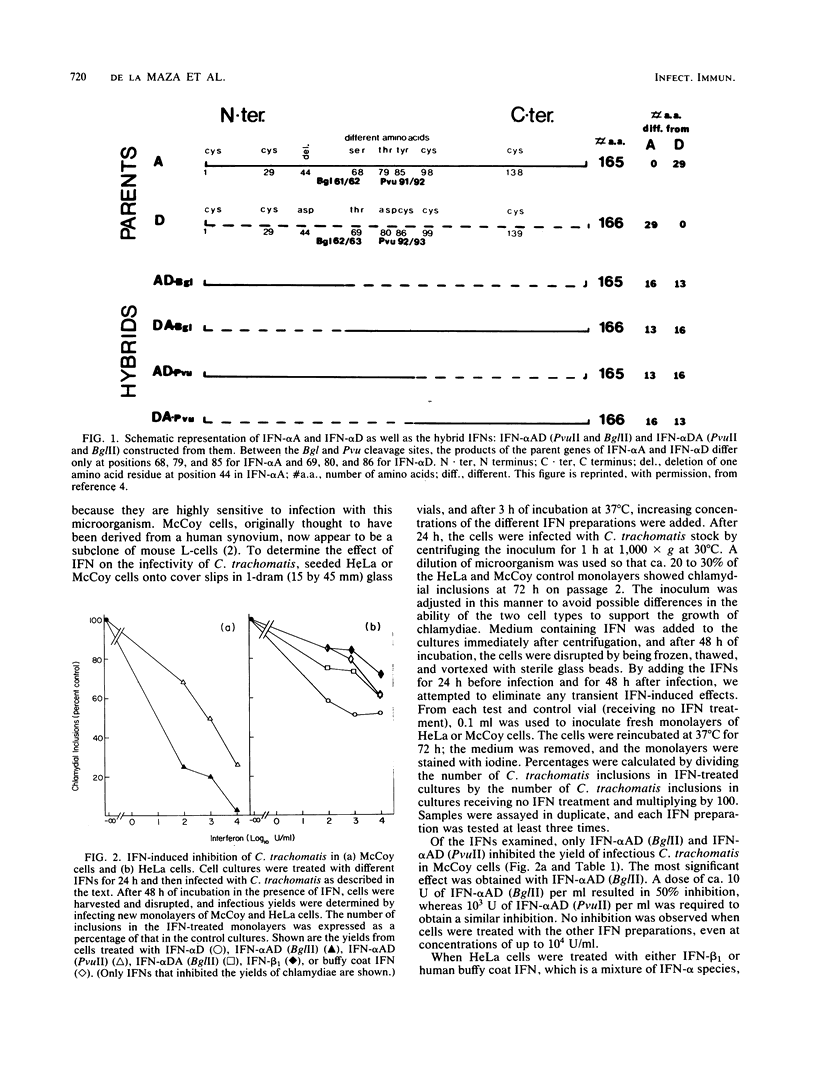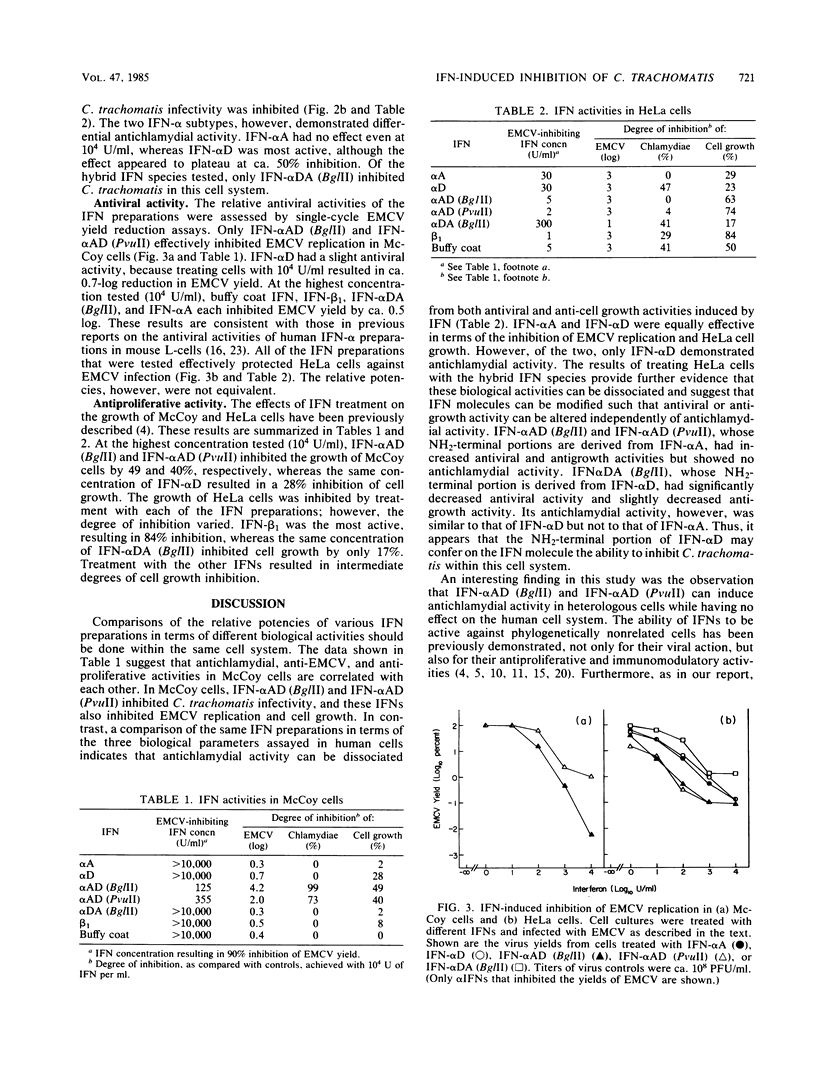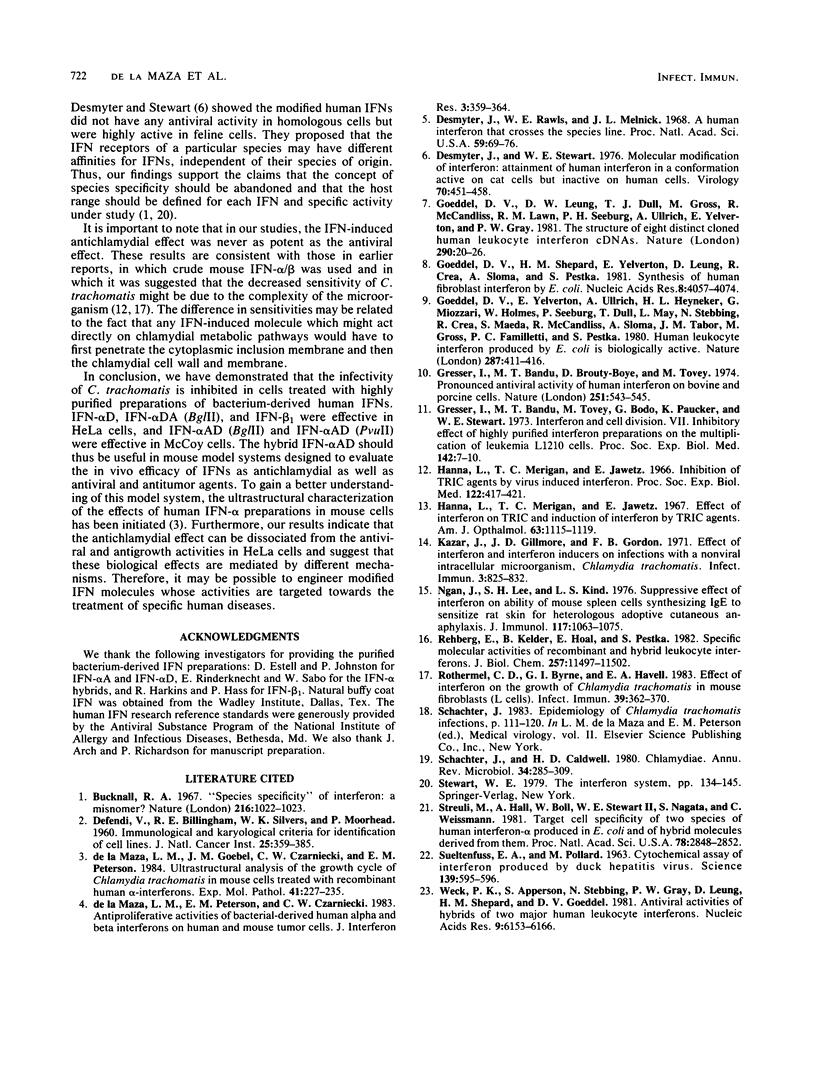Abstract
The yield of infectious Chlamydia trachomatis was analyzed in human (HeLa) and mouse (McCoy) cell lines treated with the human interferon (IFN) subtypes IFN-alpha A and IFN-alpha D, with their hybrids [IFN-alpha AD (BglII), IFN-alpha AD (PvuII), and IFN-alpha DA (BglII)] constructed in vitro from their expression plasmids, or with IFN-beta 1 or buffy coat IFN. In HeLa cells, a significant inhibition of Chlamydia infectivity was obtained with IFN-alpha D, IFN-alpha DA (BglII), and buffy coat IFN. In McCoy cells, IFN-alpha AD (BglII) and IFN-alpha AD (PvuII) induced a strong degree of inhibition of Chlamydia infectivity. In McCoy cells, there was a correlation among the antichlamydial, antiviral, and antiproliferative activities of the different IFNs tested. In HeLa cells, however, the ability of a particular IFN subtype to inhibit Chlamydia infectivity did not always correlate with its inhibitory effects on encephalomyocarditis virus replication or with its antiproliferative activity.
Full text
PDF



Selected References
These references are in PubMed. This may not be the complete list of references from this article.
- Bucknall R. A. "Species specificity" of interferons: a misnomer? Nature. 1967 Dec 9;216(5119):1022–1023. doi: 10.1038/2161022a0. [DOI] [PubMed] [Google Scholar]
- DEFENDI V., BILLINGHAM R. E., SILVERS W. K., MOORHEAD P. Immunological and karyological criteria for identification of cell lines. J Natl Cancer Inst. 1960 Aug;25:359–385. [PubMed] [Google Scholar]
- Desmyter J., Rawls W. E., Melnick J. L. A human interferon that crosses the species line. Proc Natl Acad Sci U S A. 1968 Jan;59(1):69–76. doi: 10.1073/pnas.59.1.69. [DOI] [PMC free article] [PubMed] [Google Scholar]
- Desmyter J., Stewart W. E., 2nd Molecular modification of interferon: attainment of human interferon in a conformation active on cat cells but inactive on human cells. Virology. 1976 Apr;70(2):451–458. doi: 10.1016/0042-6822(76)90286-5. [DOI] [PubMed] [Google Scholar]
- Goeddel D. V., Leung D. W., Dull T. J., Gross M., Lawn R. M., McCandliss R., Seeburg P. H., Ullrich A., Yelverton E., Gray P. W. The structure of eight distinct cloned human leukocyte interferon cDNAs. Nature. 1981 Mar 5;290(5801):20–26. doi: 10.1038/290020a0. [DOI] [PubMed] [Google Scholar]
- Goeddel D. V., Shepard H. M., Yelverton E., Leung D., Crea R., Sloma A., Pestka S. Synthesis of human fibroblast interferon by E. coli. Nucleic Acids Res. 1980 Sep 25;8(18):4057–4074. doi: 10.1093/nar/8.18.4057. [DOI] [PMC free article] [PubMed] [Google Scholar]
- Goeddel D. V., Yelverton E., Ullrich A., Heyneker H. L., Miozzari G., Holmes W., Seeburg P. H., Dull T., May L., Stebbing N. Human leukocyte interferon produced by E. coli is biologically active. Nature. 1980 Oct 2;287(5781):411–416. doi: 10.1038/287411a0. [DOI] [PubMed] [Google Scholar]
- Gresser I., Bandu M. T., Brouty-boye D., Tovey M. Pronounced antiviral activity of human interferon on bovine and porcine cells. Nature. 1974 Oct 11;251(5475):543–545. doi: 10.1038/251543a0. [DOI] [PubMed] [Google Scholar]
- Gresser I., Bandu M. T., Tovey M., Bodo G., Paucker K., Stewart W., 2nd Interferon and cell division. VII. Inhibitory effect of highly purified interferon preparations on the multiplication of leukemia L 1210 cells. Proc Soc Exp Biol Med. 1973 Jan;142(1):7–10. doi: 10.3181/00379727-142-36945. [DOI] [PubMed] [Google Scholar]
- Hanna L., Merigan T. C., Jawetz E. Effect of interferon on TRIC agents and induction of interferon by TRIC agents. Am J Ophthalmol. 1967 May;63(5 Suppl):1115–1119. doi: 10.1016/0002-9394(67)94092-5. [DOI] [PubMed] [Google Scholar]
- Hanna L., Merigan T. C., Jawetz E. Inhibition of TRIC agents by virus-induced interferon. Proc Soc Exp Biol Med. 1966 Jun;122(2):417–421. doi: 10.3181/00379727-122-31150. [DOI] [PubMed] [Google Scholar]
- Kazar J., Gillmore J. D., Gordon F. B. Effect of Interferon and Interferon Inducers on Infections with a Nonviral Intracellular Microorganism, Chlamydia trachomatis. Infect Immun. 1971 Jun;3(6):825–832. doi: 10.1128/iai.3.6.825-832.1971. [DOI] [PMC free article] [PubMed] [Google Scholar]
- Ngan J., Lee S. H., Kind L. S. The suppressive effect of the interferon on the ability of mouse spleen cells synthesizing IgE to sensitize rat skin for heterologous adoptive cutaneous anaphylaxis. J Immunol. 1976 Oct;117(4):1063–1066. [PubMed] [Google Scholar]
- Rehberg E., Kelder B., Hoal E. G., Pestka S. Specific molecular activities of recombinant and hybrid leukocyte interferons. J Biol Chem. 1982 Oct 10;257(19):11497–11502. [PubMed] [Google Scholar]
- Rothermel C. D., Byrne G. I., Havell E. A. Effect of interferon on the growth of Chlamydia trachomatis in mouse fibroblasts (L cells). Infect Immun. 1983 Jan;39(1):362–370. doi: 10.1128/iai.39.1.362-370.1983. [DOI] [PMC free article] [PubMed] [Google Scholar]
- Schachter J., Caldwell H. D. Chlamydiae. Annu Rev Microbiol. 1980;34:285–309. doi: 10.1146/annurev.mi.34.100180.001441. [DOI] [PubMed] [Google Scholar]
- Streuli M., Hall A., Boll W., Stewart W. E., 2nd, Nagata S., Weissmann C. Target cell specificity of two species of human interferon-alpha produced in Escherichia coli and of hybrid molecules derived from them. Proc Natl Acad Sci U S A. 1981 May;78(5):2848–2852. doi: 10.1073/pnas.78.5.2848. [DOI] [PMC free article] [PubMed] [Google Scholar]
- Sueltenfuss E. A., Pollard M. Cytochemical Assay of Interferon Produced by Duck Hepatitis Virus. Science. 1963 Feb 15;139(3555):595–596. doi: 10.1126/science.139.3555.595. [DOI] [PubMed] [Google Scholar]
- Weck P. K., Apperson S., Stebbing N., Gray P. W., Leung D., Shepard H. M., Goeddel D. V. Antiviral activities of hybrids of two major human leukocyte interferons. Nucleic Acids Res. 1981 Nov 25;9(22):6153–6166. doi: 10.1093/nar/9.22.6153. [DOI] [PMC free article] [PubMed] [Google Scholar]
- de la Maza L. M., Goebel J. M., Czarniecki C. W., Peterson E. M. Ultrastructural analysis of the growth cycle of Chlamydia trachomatis in mouse cells treated with recombinant human alpha-interferons. Exp Mol Pathol. 1984 Oct;41(2):227–235. doi: 10.1016/0014-4800(84)90039-x. [DOI] [PubMed] [Google Scholar]


